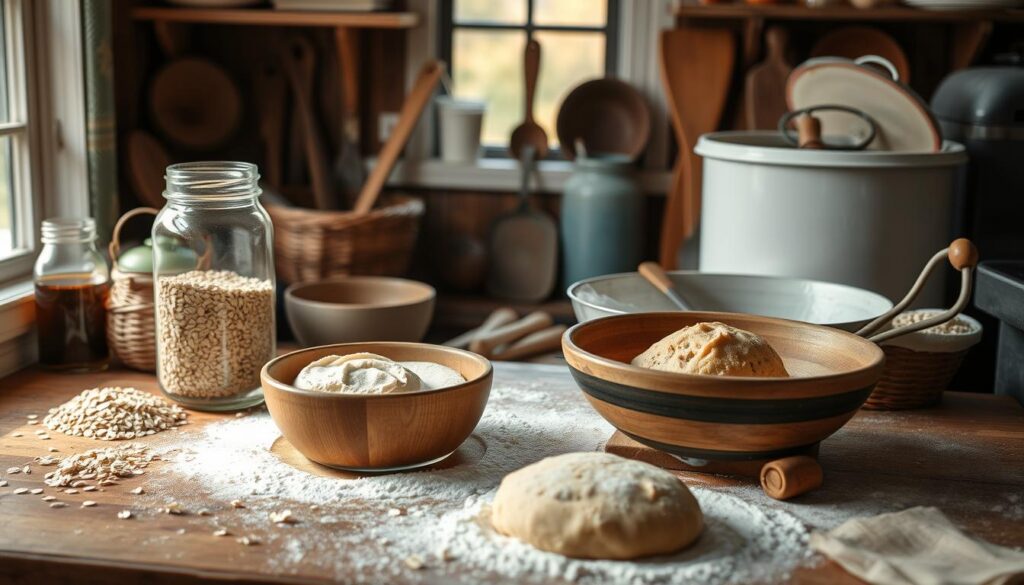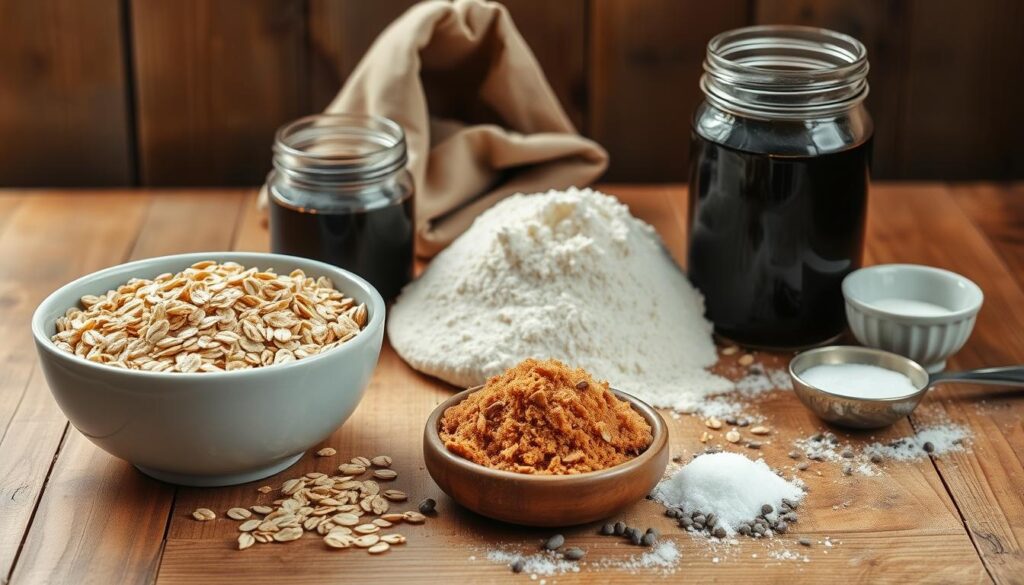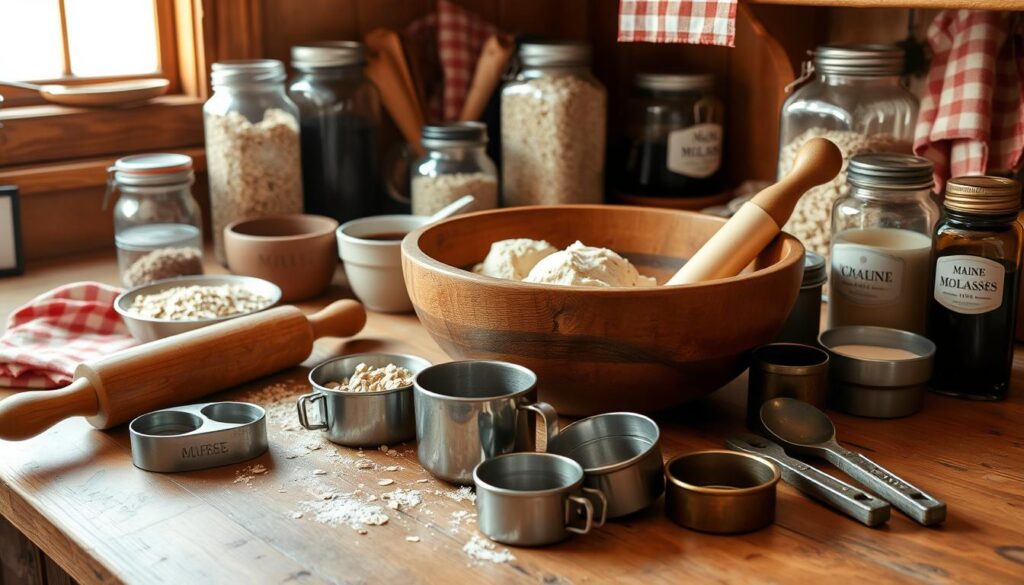Growing up in New England, the smell of fresh bread was always comforting. I remember my grandmother kneading dough, shaping a loaf that filled our home with molasses and oat sweetness. This oat molasses bread recipe maine is more than just food; it’s a tradition that connects me to my roots.

Molasses in New England baking goes back to the colonial days. It was key in gingerbread and baked beans. In Maine, oats in bread add texture and nutrition, honoring the state’s farming history. Wholesome oatmeal bread has long warmed Mainers through harsh winters.
This maine baking recipe is a true New England bread tradition. It mixes molasses’ strong flavors with oats’ heartiness. Whether you’re from Maine or just want a taste of the Northeast, this oat molasses bread recipe maine will be a favorite.
Introduction to Traditional Maine Bread Making
Maine is known for its bread-making traditions that have lasted for generations. The area’s baking history is closely tied to using local, wholesome ingredients. This includes new england bread, maine baking, and wholesome oatmeal bread. Among these, the Maine oat molasses bread is especially loved.
History of Molasses in New England Baking
Molasses has been a key ingredient in New England baking since the 1600s. It came from the Caribbean. This syrup added a unique flavor to many baked goods.
In Maine, molasses is used in oat bread recipes. It balances the bread’s nutty taste with its sweet, caramel flavor.
Cultural Significance of Oat Breads in Maine
Oat breads are dear to Mainers, showing the state’s farming roots and love for local grains. Oats have been grown in Maine for centuries. Using oats in bread is a beloved tradition.
The Maine oat molasses bread shows the state’s dedication to quality, local ingredients. It’s a symbol of Maine’s baking heritage.
Why This Recipe Stands Out
This Maine oat molasses bread recipe is unique. It mixes molasses’ rich flavor with oats’ heartiness. This creates a bread that’s both healthy and tasty.
The mix of ingredients captures Maine’s flavors, showing its farming history and baking traditions. It’s perfect on its own or as a sandwich base. This bread celebrates Maine’s baking legacy.

Essential Ingredients for Authentic oat molasses bread recipe maine
Making the perfect oat molasses bread recipe maine needs the right mix of top-notch, local ingredients. The base of this wholesome oatmeal bread comes from a few key parts:
- Rolled Oats – Organic, whole grain rolled oats add a great texture and a nutty taste. They also make the bread healthier.
- Blackstrap Molasses – Its strong, deep flavor is crucial. It gives the wholesome oatmeal bread a unique, caramel-like taste.
- Whole Wheat Flour – Mixing whole wheat with all-purpose flour makes the bread denser. It brings a rustic feel, just like Maine’s old-time baking.
- Active Dry Yeast – This yeast makes the bread light and airy. It also makes the inside soft and tender.
Try to get these ingredients from local farmers and small makers. This will help you get the real, homemade taste of this oat molasses bread recipe maine. The kind of molasses you use is key. Blackstrap molasses gives the best flavor and most nutrients.
| Ingredient | Quantity |
|---|---|
| Rolled Oats | 2 cups |
| Blackstrap Molasses | 1/2 cup |
| Whole Wheat Flour | 2 cups |
| All-Purpose Flour | 2 cups |
| Active Dry Yeast | 2 teaspoons |
With these ingredients ready, you’re set to make a wholesome oatmeal bread. It will truly capture Maine’s baking traditions and flavors.

Kitchen Tools and Equipment Needed
To make the perfect maine baking experience, you need the right tools. For this homemade rustic loaf recipe, a few essential items are key. They make the process smooth and enjoyable.
Traditional vs Modern Baking Tools
Modern appliances like a stand mixer can make mixing and kneading easier. But, traditional tools like a wooden spoon and bread peel are also very useful. Using both old and new tools can help you work efficiently.
Preparing Your Workspace
Getting your workspace ready is important for maine baking. Clear a big, clean area to work on. Make sure you can easily reach all your ingredients and tools. This makes the process smoother and keeps things tidy.
Temperature Control Essentials
Keeping the right temperature is crucial for yeast activation and rising. Use a kitchen thermometer to check the water, proofing area, and oven temperatures. This ensures the best conditions for your homemade rustic loaf.
| Tool | Purpose |
|---|---|
| Large Mixing Bowl | For combining and kneading the dough |
| Wooden Spoon | For stirring and mixing the dough |
| Measuring Cups and Spoons | For accurately measuring ingredients |
| Bread Pan | For shaping and baking the loaf |
| Kitchen Thermometer | For monitoring temperature during proofing and baking |

Step-by-Step Mixing and Kneading Process
Making the perfect oat flour bread or homemade rustic loaf starts with careful mixing and kneading. Begin by waking up the yeast in warm water, adding a bit of molasses to start the fermentation.
Then, mix the dry ingredients like oats and flours in another bowl. Slowly add the wet and dry parts together. Knead the dough until it’s smooth and elastic. This step, which takes 10-15 minutes by hand or 5-7 minutes with a mixer, is key for the right texture.
- Proof the yeast in warm water (120-130°F) with a dash of molasses.
- In a separate bowl, mix the oat flour, all-purpose flour, and other dry ingredients.
- Gradually incorporate the wet and dry ingredients, kneading the dough until it becomes smooth and elastic.
- Knead the dough for 10-15 minutes by hand or 5-7 minutes in a stand mixer.
- Proper kneading is crucial for developing the gluten structure and achieving the ideal texture.
| Ingredient | Amount |
|---|---|
| Whole Wheat Flour | 2.75 cups |
| All-Purpose Flour | 1 cup |
| Mixed Seeds (Flax, Sunflower, Sesame) | 1/2 cup |
| Salt | 1 tablespoon |
| Instant Yeast | 1 tablespoon |
| Honey | 1 tablespoon |
| Egg Wash (Egg + Water) | 1 large egg + 1 tablespoon water |
“Proper kneading is the key to unlocking the full potential of your oat flour bread or homemade rustic loaf.”
Proper Fermentation and Rising Techniques
Getting the perfect rise is key for a great breakfast bread or rustic loaf. The rising process needs time, temperature, and visual signs. Knowing these steps helps your Maine oat molasses bread turn out amazing.
First Rise Guidelines
Let the dough rise in a warm, draft-free spot for 1-2 hours. It should double in size. This step is crucial for a light, airy texture. Watch the dough closely to avoid a dense loaf.
Second Rise Tips
Gently punch down the dough after it rises. Shape it into your preferred form, like a batard or boule. Let it rise again for 30-45 minutes. This step helps the dough keep its shape and improves the texture.
Visual Cues for Perfect Proofing
- Look for a slightly rounded, puffy top on the dough.
- Gently press the dough with your finger – it should spring back slowly, indicating it’s ready for baking.
- Avoid over-proofing, which can cause the dough to collapse or become misshapen.
Watching the dough closely during rising is crucial for a great crumb and crust. Follow these tips to bake a delicious Maine oat molasses bread.
Baking Temperature and Timing Guide
To make the perfect oat molasses bread recipe maine or homemade rustic loaf, you need to get the temperature and timing right. Here’s how to do it:
First, preheat your oven to 375°F (190°C). This temperature is just right for baking the bread evenly and getting a nice golden crust. Bake the bread for about 35-40 minutes, watching it closely.
Check the bread’s internal temperature with an instant-read thermometer. It should read 190°F (88°C) to know it’s fully baked. If the crust is getting too dark, cover it with foil to stop it from burning.
Keep in mind, every oven is different. You might need to adjust the time and temperature for your oat molasses bread recipe maine or homemade rustic loaf to get the best results.
| Baking Step | Time | Temperature |
|---|---|---|
| Preheat Oven | – | 375°F (190°C) |
| Bake Bread | 35-40 minutes | 375°F (190°C) |
| Check Internal Temperature | – | 190°F (88°C) |
By sticking to these temperature and timing tips, you’ll make a perfectly baked oat molasses bread recipe maine or homemade rustic loaf every time.
Storage and Serving Suggestions
After baking your hearty breakfast bread, let it cool on a wire rack. This step is key to avoid moisture and get the right texture. Store your molasses sweetened bread in an airtight container at room temperature for up to 3 days.
For longer storage, freeze your oat molasses bread. Wrap it in plastic wrap and foil, then freeze for up to 3 months. To serve, thaw at room temperature.
Serving Recommendations
This traditional Maine-style bread is perfect for many occasions. Try it toasted with butter for a tasty breakfast. It’s also great for sandwiches or with soups and stews.
| Serving Suggestion | Description |
|---|---|
| Breakfast Bread | Enjoy a slice of the hearty breakfast bread toasted with butter for a satisfying morning meal. |
| Sandwich Base | Use the molasses sweetened bread as the foundation for delicious sandwiches, such as grilled cheese or roast beef. |
| Soup Accompaniment | Pair the oat molasses bread with your favorite hearty soups and stews for a comforting and filling meal. |
Letting the bread cool completely is essential for enjoying it. With good storage and creative ways to serve, you can enjoy Maine’s famous hearty breakfast bread for days.
Troubleshooting Common Issues
Baking the perfect oat flour bread or homemade rustic loaf can be tricky. But, with some troubleshooting, you can solve common problems and get great results. Let’s look at some frequent issues and how to fix them.
Dense Texture
If your oat flour bread or homemade rustic loaf feels dense, it might be because of under-kneading or not enough rising time. Make sure to knead the dough well, as the recipe says. Also, let it rise for the full time until it doubles in size.
Dry Bread
If your bread is too dry, try adding a bit more liquid. Adjust the water, milk, or other liquids in the recipe. Keep trying until you get the right moisture.
Gummy Texture
A gummy or undercooked texture means your bread needs more baking time. Check the internal temperature and let it cool completely before slicing. This ensures it’s fully baked.
Remember, every oven and environment is unique. You might need to adjust the ingredients and baking times for your setup. Don’t hesitate to experiment and tweak the recipe until you get it just right.
“Baking is both an art and a science, and troubleshooting is an essential part of the process. With a little patience and experimentation, you can master the art of creating delicious, consistent oat flour bread and homemade rustic loaves.”
Conclusion
This Maine Oat Molasses Bread recipe is a loving tribute to New England’s baking heritage. It combines wholesome oats and molasses for a taste of Maine in every slice. The mix of overripe bananas, pumpkin puree, and chocolate chips adds a special touch.
The brown butter and vanilla extract make the bread even sweeter. This recipe is perfect for both experienced bakers and newcomers. It lets you bring a piece of Maine into your home.
Try adding nuts or seeds to make the bread your own. Yet, it still keeps its rustic charm and hearty taste. With care and the right techniques, you can make a loaf that embodies the spirit of new england bread and wholesome oatmeal bread.
So, get your ingredients ready and preheat your oven. You’re about to enjoy the taste of Maine in every bite. This oat molasses bread recipe maine is a true treat that will make you want more of the Northeast’s comforting flavors.

